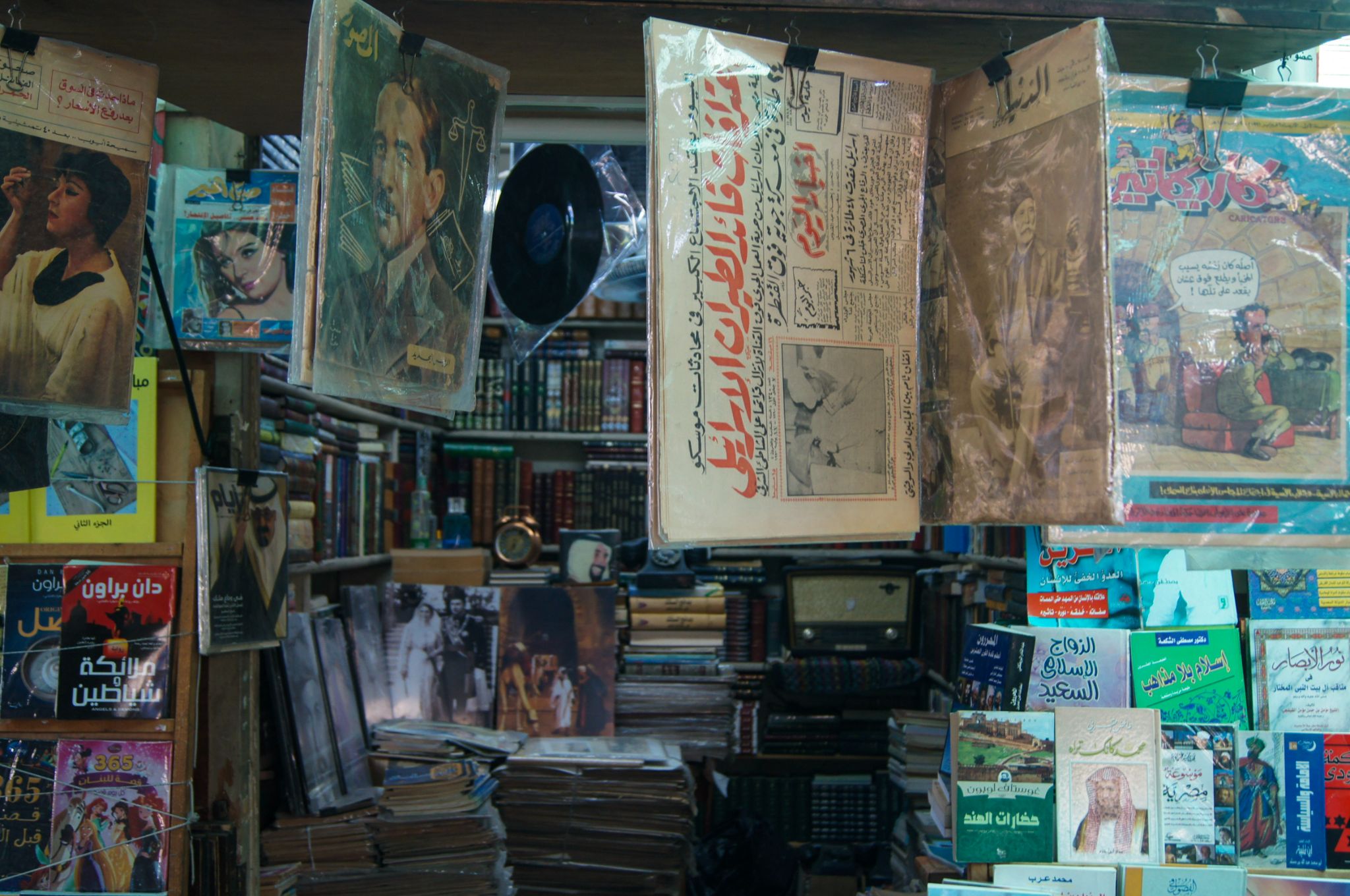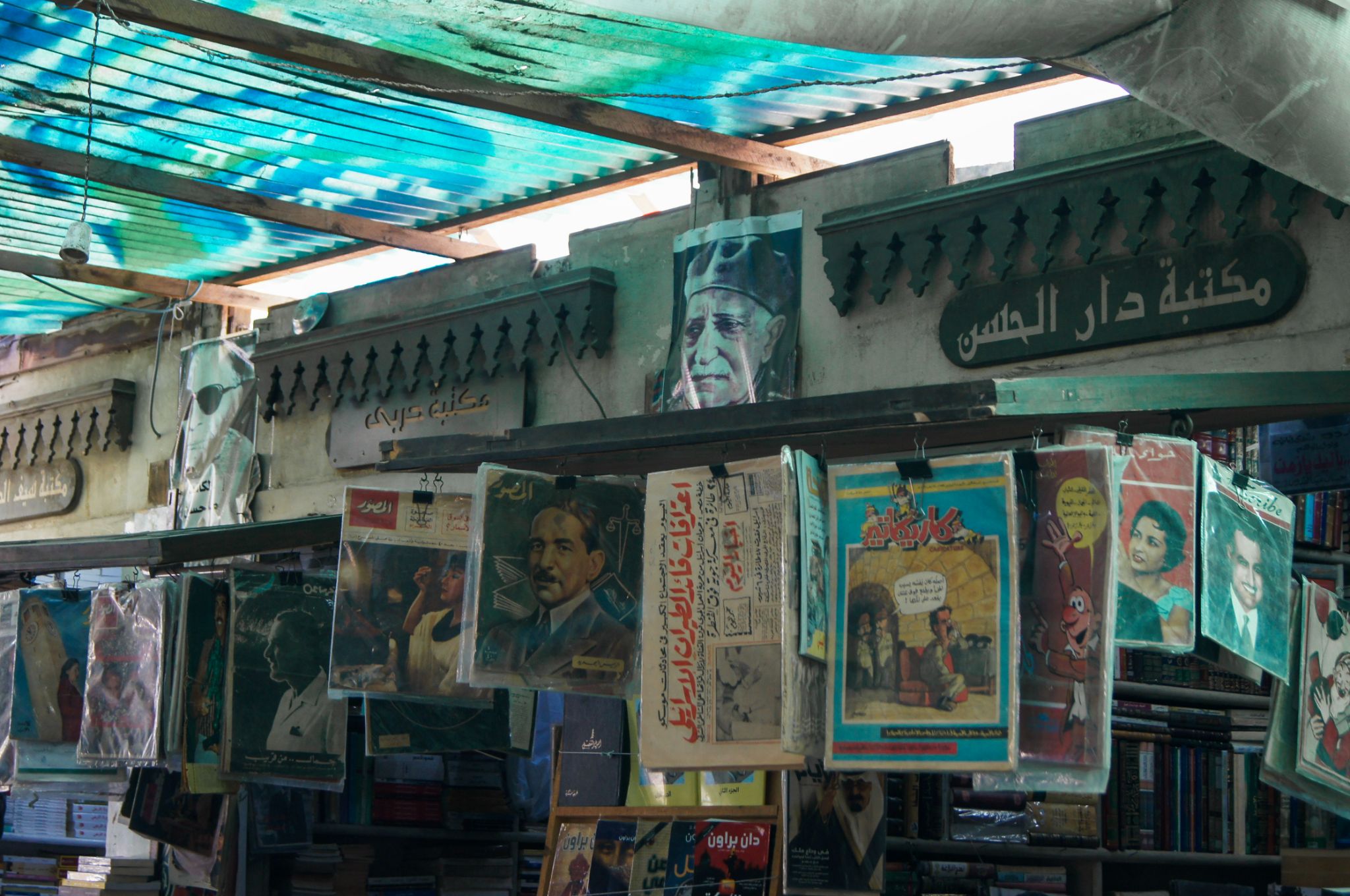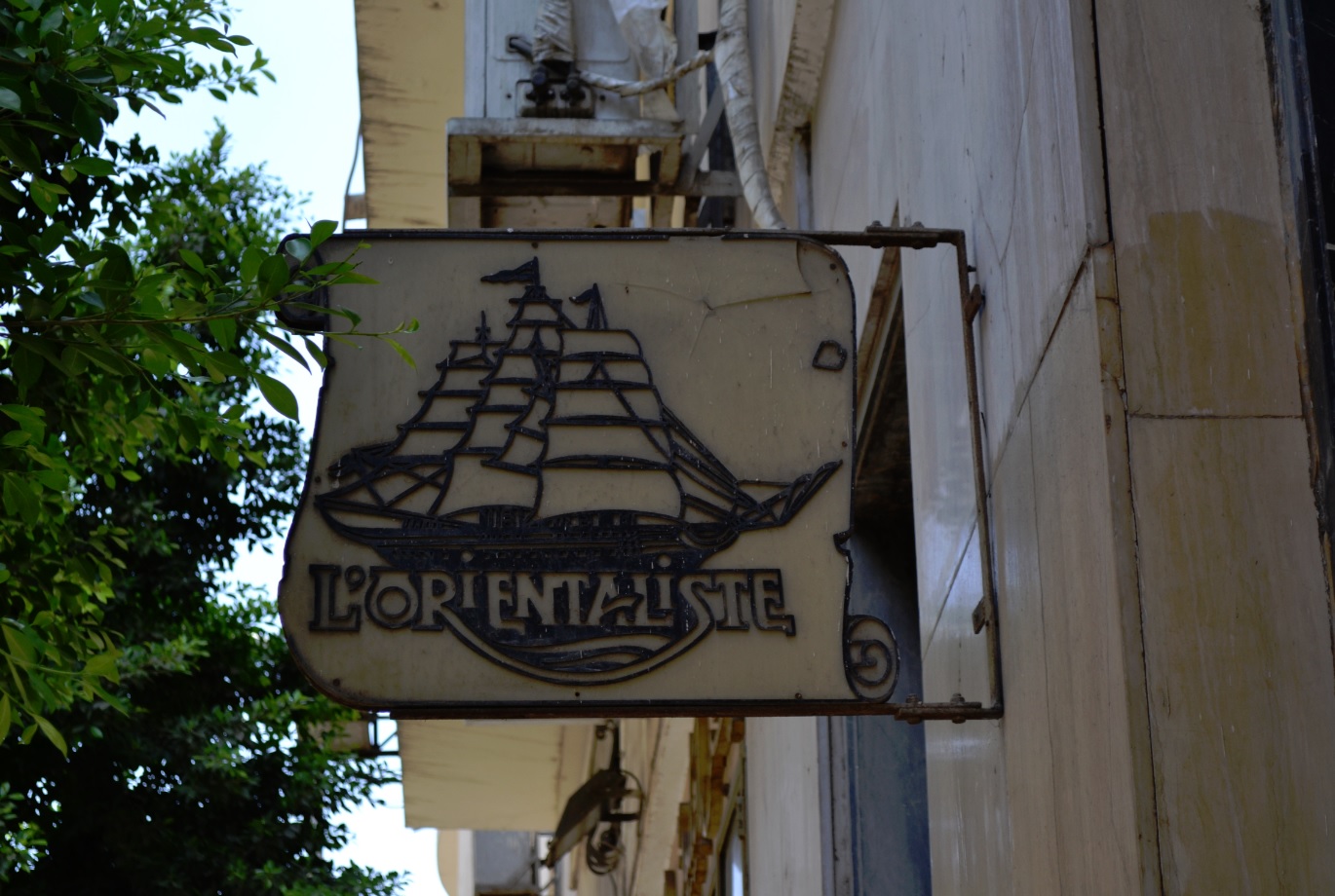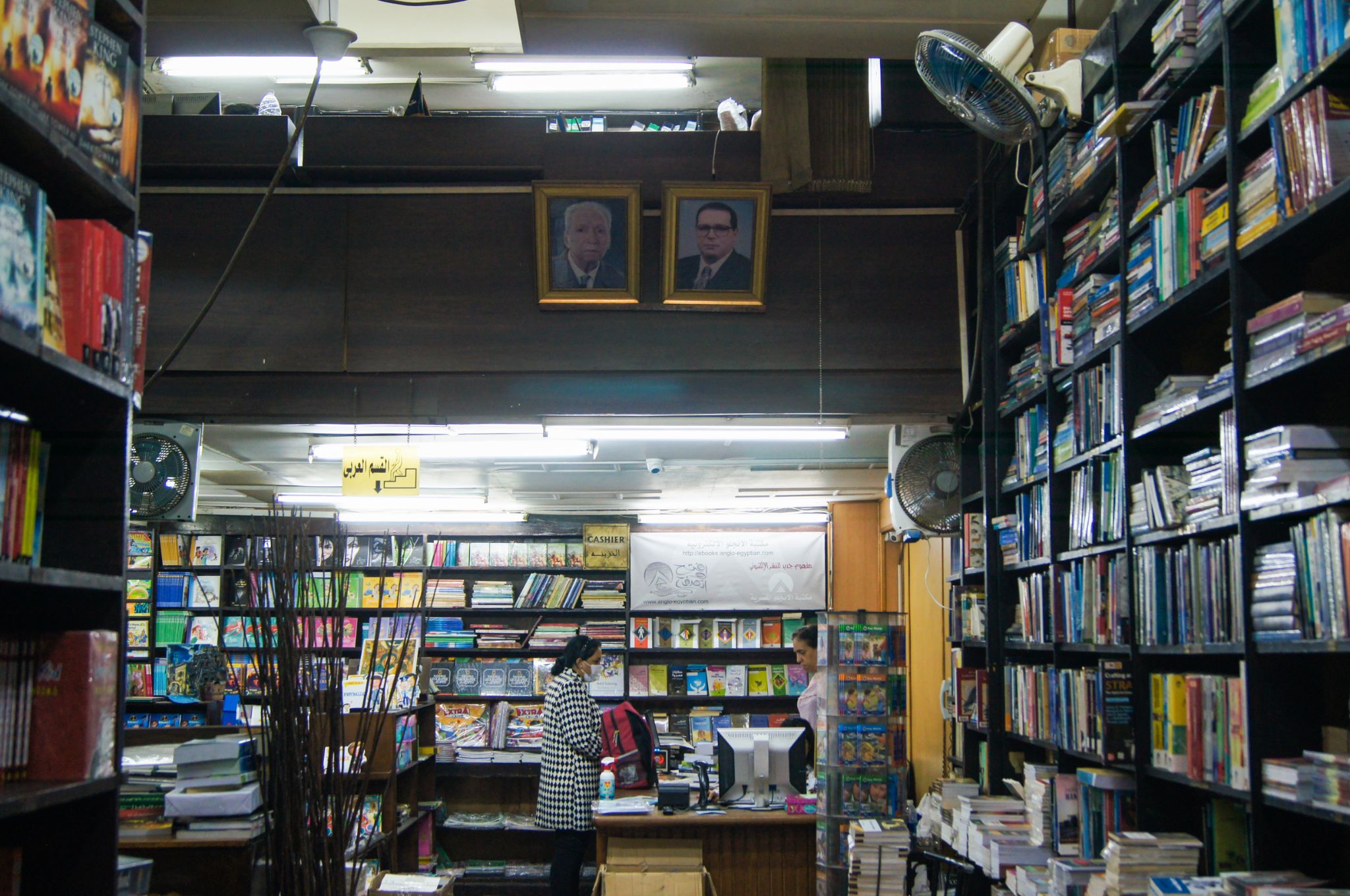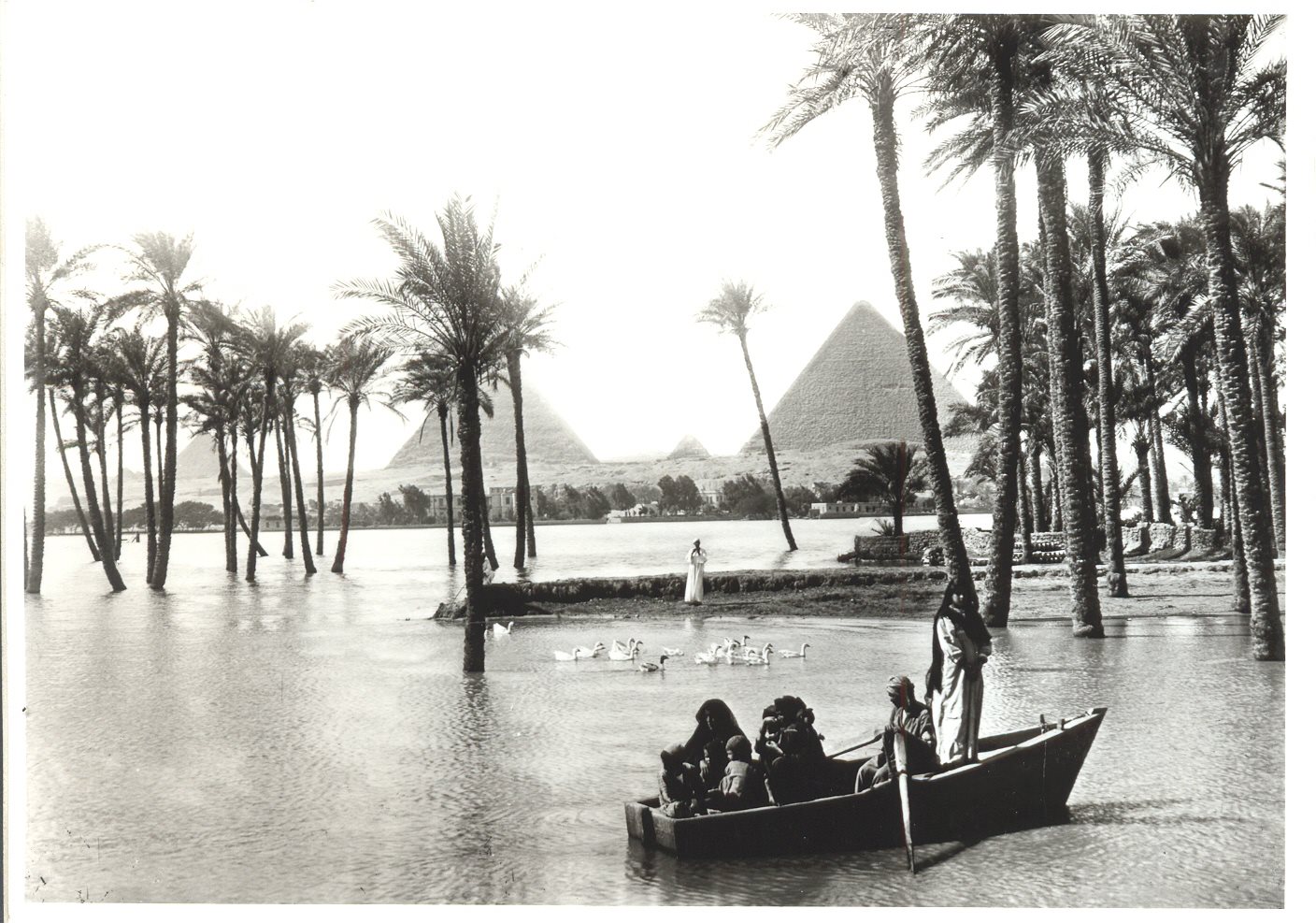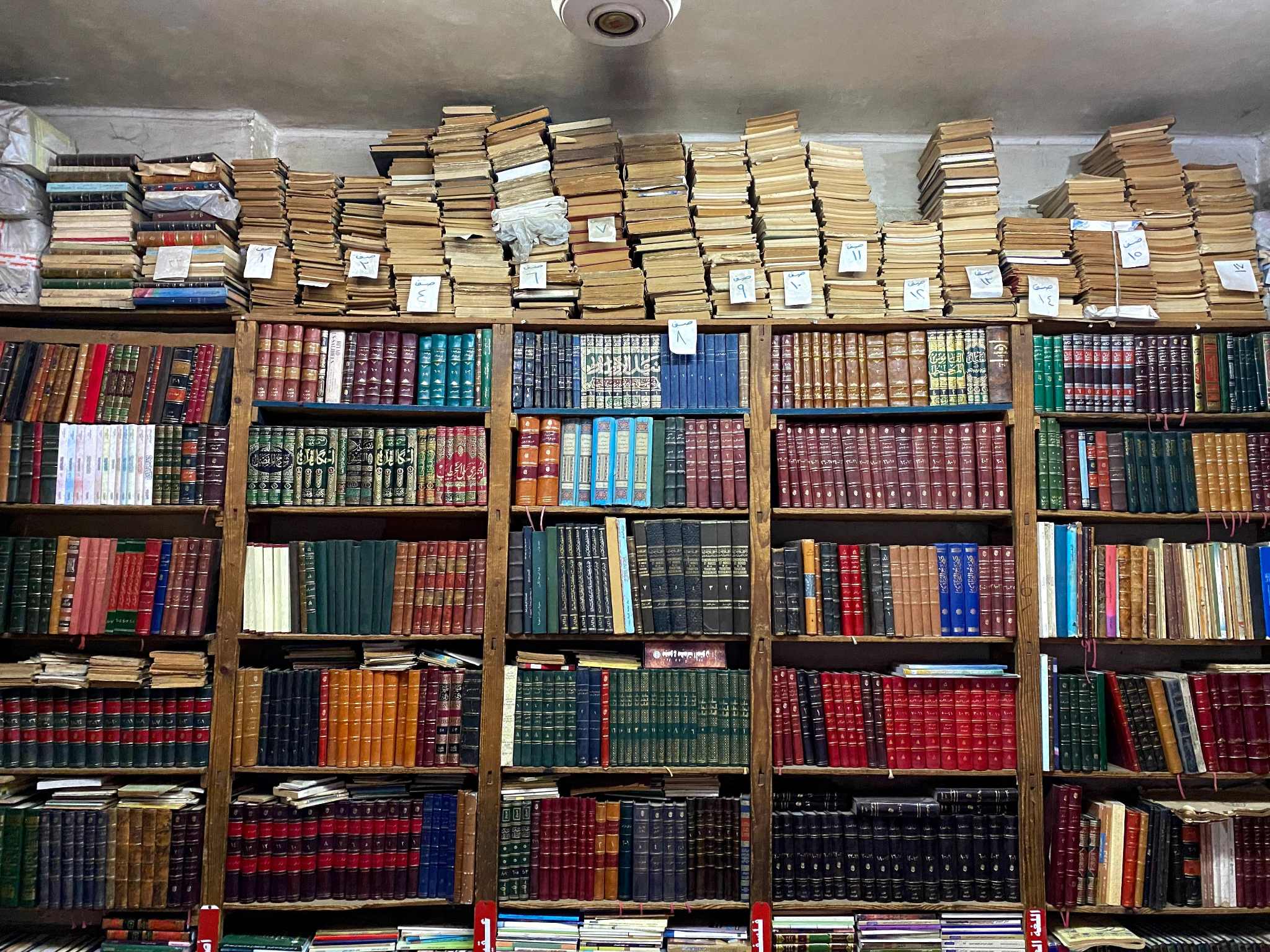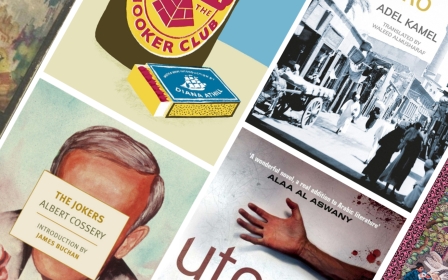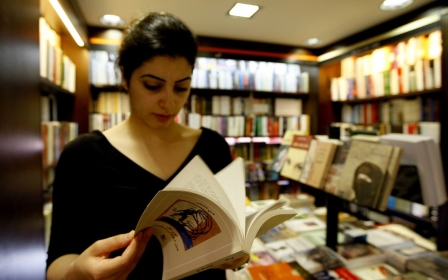City of a thousand booksellers: Eight of the oldest places to buy books in Cairo

Cairo’s literary history is long and complex, with many bookshops launched as accompaniments to the country and the region’s first publishing houses.
Dar El Maaref, for instance, is the oldest Egyptian publishing house, established in 1890, with the first branch of its bookshops opening in 1910, and still standing today in Ramses.
A search for the city’s oldest bookshops makes for quite the urban adventure. Through a millennia-old archway, hundreds of leather-bound volumes are stacked floor to ceiling.
Or turn away from one of Cairo’s most iconic roundabouts and you’ll discover - between a travel agency and an electronics store - a 19th century orientalist’s library, replete with jaw-dropping first editions and vintage maps.
New MEE newsletter: Jerusalem Dispatch
Sign up to get the latest insights and analysis on Israel-Palestine, alongside Turkey Unpacked and other MEE newsletters
Above one of the city’s busiest metro stations, affordable prints and one-of-a-kind collectors’ items burst out of the 132 used book stores that sprawl through a book market over a century old.
It’s an eye-opening walking tour, made a little easier by the fact that in Cairo’s older neighbourhoods, independent shops of the same kind are usually huddled together. For books, that means right behind al-Azhar Mosque, across the street from the historic Khan el-Khalili souk, along Abd el-Khalik Tharwat Street in downtown Cairo, a few minutes away from Tahrir Square, and scattered around the iconic sprawl of Soor el-Azbakeya (the Azbakeya Wall Book Market).
While the stores featured in the following list are remarkable testaments of resilience - with most surviving through the waning years of British occupation; the last Egyptian monarchs; a new age of state-building, as well as decades of economic reconstruction; war and revolution right outside their doors, and inevitable industry upheaval - others have been less fortunate.
Many bookshops have turned into stationary stores in the past half century, or completely pivoted industries. Wahib & Co., Maison de Reliure, was one of the last bookbinding ateliers, before transitioning to sell safes and safety deposit boxes a decade ago, bringing in a more stable revenue. A little worn down, the store sign on Abd el-Khalik Tharwat Street remains the same, and the owner still keeps the mammoth binding equipment stored in the back.
The following are some of the city’s oldest, iconic bookshops, where you can hold an 18th century edition of Voltaire in your hands, retrace the literary salons of Naguib Mahfouz and Taha Hussein, comb through rare vintage prints, and have the books you’ve picked up leather-bound at one of the city’s last surviving bookbinders.
1. The Azbakeya Wall Book Market
Technically, Soor el-Azbakeya isn’t a single bookshop, but 132. It’s known as the Azbakeya Wall for its location, right by the fence of the famed Azbakeya Gardens, off Opera Square. It was first formed in 1907 quite spontaneously, as street vendors who would roam downtown chose the spot to rest, only to find customers coming to them.
The vendors decided to stay put, which started a decades-long feud with the government, who would continuously try to remove them - sometimes blasting fire hoses that would destroy the books - until the market was legalised and the vendors licensed for the first time in the 1940s.
Today, each of the sprawling market’s shops has its name in Arabic type overhead, in a standardised mashrabiya-inspired design to resemble old stores. With new books largely staying within the EGP50 ($3) mark, and many being sold for between 30 cents and a dollar, the market is by far the best option for readers on a budget.
The reason why the books are so cheap is also why there are a surprising number of new English publications, including the most popular young adult and science fiction releases: a lot of them are pirated, which is clear by the off-margin printing and the typos on the cover. Many, however, are second hand, selling at a fraction of the price of new books.
The market is also the holy grail for researchers of modern Arab history. The range of vintage newspapers and magazines, as well as old film posters, is unparalleled. Reading the headlines of Al Ahram and Al Akhbar is fascinating (the front page of a June 1953 Al Joumhouria announces: "President Naguib becomes president of the republic and prime minister, Gamal Abdel Nasser his vice and minister of interior").
Early editions of the weekly magazine Al-Musawar are a treasure trove of Arab visual history. Old comic books like Samir and Sindbad are charmingly nostalgic. And rare finds are capsules of history, like a 1958 edition of Al Qowat Al Mosallaha (The Armed Forces Magazine) that offers a first person account of the war for independence in Algeria.
2. L’Orientaliste
On Kasr Al Nile St., two blocks away from Tahrir Square, the antiquarian bookshop L’Orientaliste lives up to its name. Ayman Farahat, who has been working in the store for 32 years, says the store was first established in the late 1800s, when downtown Cairo was first being built.
Thousands of heavy volumes dating as far back as the 18th century line the creaking shelves. The French Description de l'Egypte, which first appeared in 1809 - and was later described by Edward Said as "that great collective appropriation of one country by another" - can be found here, alongside seven volumes of derelict Voltaire and hundreds of first-edition Egyptology scholarship in French and English.
Barely an inch of the store is left uncovered, with a large collection of vintage maps, original David Roberts lithographs, and illustrations hanging in gold frames in every direction.
More museum than bookshop (though everything is for sale), entering the space feels like falling into a 19th century orientalist’s mind. As a result, much of the store is in equal parts fascinating and uncomfortable, including photos of Egyptian peasants and Sudanese tribesmen, illustrations of temples that would spawn Egyptomania, and prints of one-dimensional orientalist paintings.
Many items, however, are marvellous connections to history, such as the original sheet music for the annual procession of the kiswa - the cloth fabric that covers the Kaaba, which was made in Egypt from the 12th century until 1962 - out of Cairo to Mecca.
The bookshop was sold to the late Egyptian actor and long-time regular Hassan Kamy by its former Jewish Swiss owner, a Mr Feldman, who left Egypt in 1967 after the Six Day War. Kamy gifted the store to his wife, who passed away in 2012, after which the actor said he intended the store be made into a cultural foundation. When Kamy died in 2018, ownership of the store passed to his lawyer, who revealed papers that indicated the actor had sold the store to him.
3. Dar El Maaref
Dar El Maaref was first established as a publishing house by Lebanese poet Najib Mitry in 1890 in the neighbourhood of Fagallah by Ramses Square, across the street from the train station. At the time, this part of Cairo was home to a sizeable Levantine community, and would later come to be known as the centre of Egypt’s nascent publishing industry.
In 1910, Mitry opened Dar El Maaref’s first store, in the same building as the publishing house. It quickly became a literary salon, featuring regulars such as Egyptian "prince of poets" Ahmed Shawky and Lebanese "poet of two countries" Khalil Mutran.
The publishing house would soon become a household name, responsible for iconic publications such as children’s magazine Sindbad in the 1950s and literary periodical Iqraa, which featured authors like Taha Hussein and Abbas El-Akkad. In 1963, as part of President Gamal Abdel Nasser’s programme of economic restructuring, Dar El Maaref was nationalised, and remains in the public sector today. In 1976, prolific Egyptian writer and thinker Anis Mansour was tapped by President Anwar El-Sadat to establish October Magazine, a weekly political magazine that remains the publisher’s flagship project.
With 22 branches across the country, Dar El Maaref is still one of the country’s largest bookstores. Its oldest branch remains in the same spot, on what is now known as Kamal Sedky St., standing sentinel as the neighbourhood transformed from clusters of publishing houses to the go-to neighbourhood for stationery, school supplies, and educational books. As a result, the area is more likely to satisfy frazzled parents than avid readers.
Even so, Mohamed Ahmed, who has been working in the store for 20 years, has witnessed what comes and goes in the Egyptian book market, and what stays the same. “There’s been a huge difference over the past two decades,” he tells Middle East Eye, his reflection punctuated by a series of customers enquiring about a seventh-grade study guide, an Islamic history book, and English-language fiction.
“But there are some things, which we consider the heritage of Dar El Maaref - titans like Taha Hussein and Abbas El Akkad - whose works have never gone out of fashion, even as the young generation gravitate more towards fiction and popular novels."
4. The Anglo-Egyptian Bookshop
First founded in 1928, the Anglo-Egyptian Bookshop still stands in one of downtown Cairo’s most iconic buildings, at the intersection of Mohammed Farid and Adly St. Most of its tall wooden shelves are full of educational books in English, with a revolving door of flustered students coming in to request them
Its large literature section features classics from the likes of Jane Austen for less than a couple of dollars, a third of the price in many chain bookshops.
The shop was founded by publisher Sobhi Greiss, who modelled it on a Cambridge library, and whose grandsons Khaled and Karim still operate the store today. Gereiss quickly became a public figure to the English, particularly Queen Elizabeth, as the first to export English culture into the Middle East.
The Anglo-Egyptian Bookshop has been a bilingual publishing house and distributor for nearly a century, originally making a name for itself as the go-to for literary classics, as well as a pillar of the local cultural scene. “My grandfather would host these grand literary salons here,” Khaled Greiss tells Middle East Eye. “Taha Hussein, Naguib Mahfouz, Abbas al-Aqqad - who, ironically, was the only one whose work we actually published - would be here once a week with my grandfather.”
“Seventy years ago, this entire area housed the creme de la creme of Cairo society, and they were a very cultured community. Every week, when they’d do their shopping, they’d be sure to buy a book or two. More and more bookshops flocked to the area, bringing other stores with them, until downtown became a sprawling shopping district.”
Until the 80s, Anglo-Egyptian was the main source of English books in the city. Then other foreign-focused stores opened post-liberalisation, in addition to the chain stores of the 2000s. Today, the bookshop's early focus on English-language literature, medicine, and philosophy - which was in high demand 90 years ago - has expanded into bilingual educational material in every field, with a particular focus on psychology, in addition to its literature section.
5. Madbouly Bookshop
Established in 1951, Madbouly Bookshop on Talaat Harb Square is the youngest spot on this list, at a mere 70-years old. The story of Haj Madbouly, the illiterate publisher who went from newspaper salesman to one of Cairo’s literary heavyweights, is still a favourite amongst the booksellers of downtown Cairo, affectionately relayed whenever any of them are asked about the history of bookshops in the area.
Hajj Madbouly had started working with his father in 1944, selling books and magazines when he was just six-years old. In 1951, the family began renting a newspaper kiosk on Talaat Harb Square, where he and his brother would work in shifts. By 1958, the business had expanded to rent the landmark store, as well as a small publishing house feeding what Madbouly called an intellectual renaissance.
“We started publishing after the Suez Canal crisis [of 1956],” Madbouly said in an interview a few years before his death in 2008. “The revolution had invigorated intellectual and cultural life, and there was suddenly this large cultural movement that would produce the iconic Egyptian thinkers that we know today... The General Egyptian Book Organisation would publish a book every six hours, and it would immediately sell out.”
After first starting with translations of the works of Jean Paul Sartre, Albert Camus and Samuel Beckett, the publisher went on to put out thousands of releases, including by Nawal el-Saadawi, Gamal el-Ghitani and Mohamed Hassanein Heikal. After the defeat of 1967, Madbouly became known for selling and publishing books banned by the Nasserist government.
Today, the store - now owned and managed by Mohamed Madbouly, Hajj Madbouly’s son - carries new publications in Arabic literature and research. A closer eye, however, reveals the remnants of decades-old prints that never sold out, including beautiful poetry collections in ornate hardcovers and fascinating niche historical scholarship.
6. Lehnert and Landrock
In 1904, Bohemian photographer Rudolf Franz Lehnert met Swiss businessman Ernst Heinrich Landrock while travelling and taking photos. The pair established their first studio for orientalist photographs in Tunis, before moving their business to Cairo in 1924.
Lehnert and Landrock was originally a studio. The first brick and mortar bookshop was opened on Sherif Street in downtown Cairo in 1936 by Landrock’s stepson Kurt Lambelet, who expanded the business to include German books and a small English section.
Over the years, the bookshop and art gallery has existed in several locations, including inside the Egyptian Museum in Tahrir until 2004. Today, the store has two branches: one downtown location on Abd El-Khalik Tharwat St., a 15-minute walk from Tahrir Square, and the other just across the river on Zamalek island.
In addition to the bookshop’s expanded German and English sections, and a section dedicated to Egyptian handicrafts, its main attraction is the vast collection of photographs still preserved and on display. In prints, postcards, and coffee table books, visitors can see Lehnert’s photographs of Tunisia, Palestine, and Egypt in the early 1900s.
Said Ali has been working in the store since 1976, when he was 17 years old. His is a genuine love for the bookshop, the gallery, and what he sees as the boundless heritage they hold.
“These photos are our heritage,” he says, while flipping through an album of Lehnert’s photographs from the Egyptian countryside, which include perfectly composed shots of rolling fields, stately portraits of farmers, and a hard-to-conceive shot of the flooding Nile at the foot of the pyramids. “So many Egyptians don’t know about these images, they don’t know our history exists in photos like this. So we try to hold galleries and exhibits when we can.”
7. The Azhary Heritage Library
As Abdel Salam Fahmy, the manager of the Azhary Heritage Library, explains the bookshop’s history, two foreign students come in looking for an Uzbek translation of the Quran, which Fahmy doesn’t carry. He directs them to a store that does. It's only half a block away, one of a dozen huddled together behind al-Azhar, which together cater to the thousands of students that study in al-Azhar University from all around the world.
The Azhary Heritage Library is small and nearly underground, though the publishing house and bookshop (originally named El Maktaba El Mohamadeya, the Mohammedan Library) has been in business since 1930.
It was established by Mohamed Afendi Embabi El-Minyawy, whose son Haj Mohamed renamed the business into the Azhary Heritage Library in 1988. Now in his 70s, Haj Mohamed still chooses the manuscripts for publication himself.
Though it mainly caters to Azhar students in the area, the bookshop carries and publishes Arabic books in a large array of topics, including linguistics, jurisprudence, history, and philosophy.
8. Abdelzaher Book Binding
By the mid-1930s, a growing book industry had formed in Egypt. Dar El Maaref in Faggalah was increasingly surrounded by more and more publishing houses. The Anglo-Egyptian Bookshop was quickly establishing a foothold in its market. Soor El Azbakeya was thriving, albeit still a few years away from official legalisation.
And a stone’s throw away from Khan El-Khalili in Darb El Ahmar, a craftsman named Ali Hegab was establishing his traditional bookbinding business, which would thrive as Egypt continued to read more and more. With his apprentice and cousin, Abdelzaher Ibrahim, the pair developed their signature binding style of combining a leather spine and vinyl sides.
Today, the atelier is owned and managed by Abdelzaher’s grandchildren, with a workshop nearby where their team is some of the last to practise the traditional handicraft. In a corner of the store itself, you can often see Yasser Abdelzaher embossing volumes with gold letters, the final step of the process.
The shop sells beautiful journals and sketchbooks made in the signature style, small gifts and other handicrafts, and a small selection of books, including AUC Press titles and Egypt-focused coffee-table books. On display in a corner of the store is also a portion of Abdelzaher Ibrahim’s library of vintage books, which include out-of-print treasures, but aren’t for sale.
This writer recommends saving Abdelzaher for last, where you can learn about a dying craft, as well as get the books you’ve picked up along the way leather-bound, which makes for a fantastic gift.
Middle East Eye delivers independent and unrivalled coverage and analysis of the Middle East, North Africa and beyond. To learn more about republishing this content and the associated fees, please fill out this form. More about MEE can be found here.


